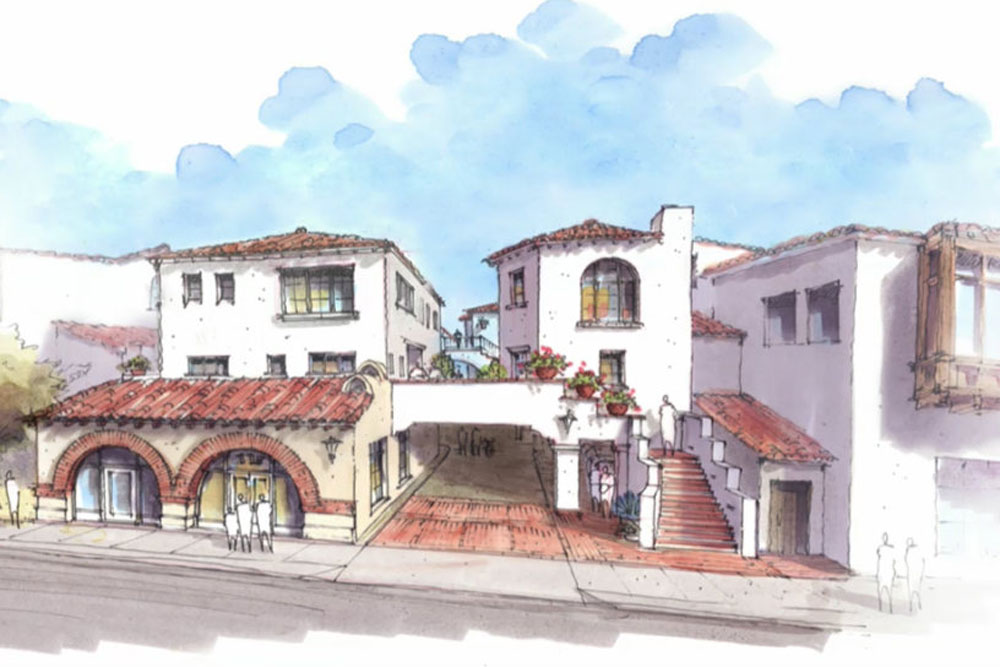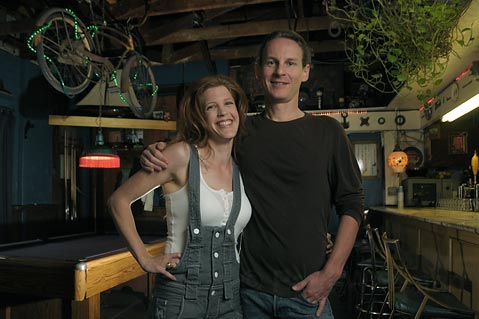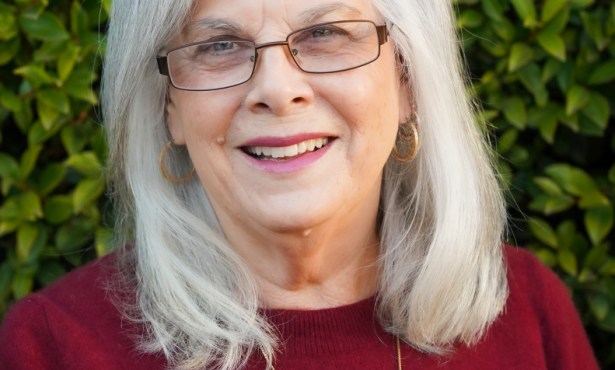New Apartments Planned to Replace Elsie’s Tavern
Proposed High-Density Housing Development Got Overall Thumbs Up from Planning Commission

A proposal to knock down the popular Elsie’s Tavern dive bar on West De la Guerra Street to make room for a 23-unit apartment project was generally well received by the city’s Planning Commission at a recent design hearing.
The commissioners called the property — sandwiched between Paseo Chapala and One Twenty One, two mixed-use condominium complexes — a prime location for new downtown rental housing, and they said the plans made smart use of the city’s incentive program for high-density development. But they also advised bringing down building heights from four to three stories and tweaking wall and window locations for better light and airflow.
As it’s currently designed, the project includes 13 one-bedroom apartments, 10 two-bedroom units, 1,162 square feet of commercial area, and 26 parking spaces. The façade and roof of the double-archway W.D. Smith Building — a historic “Structure of Merit” next to Elsie’s — would be preserved. Elsie’s itself — a single-family home built sometime in the 1890s that’s housed the mirthful beer and wine bar for the past 24 years — would be demolished.
Property owner John DeWilde said, however, that it would be “a while” before the plan comes to fruition. He predicted at least two years, given the necessary permits, approvals, loans, and building contracts he must secure before construction can begin. And that’s assuming the market is still friendly toward rental development. DeWilde has promised to give Elsie’s operators, with whom he has a close and communicative relationship, ample warning before any major moves are made. He’s also offered to pay their relocation costs. “We’re good for a while,” said Elsie’s owner Pete Degenhardt. “If something happens, we’re going to move. We’re not going to close.”
DeWilde, who owns Santa Barbara Valet, was previously permitted, back in 2006, to build condos on the property. But he changed his mind after market conditions changed and after observing the purchasing patterns of buyers on either side of him at Paseo Chapala and One Twenty One. “It kind of hit me that they were attracting second-home buyers who are here just a few weeks a year,” he said, remarking on Santa Barbara’s crisis-level housing shortage. “They’re perfectly nice people — I like talking to them — but I don’t think it’s what the town needs.

DeWilde said it’s far too soon to say what rental rates he expects his new development to fetch but that one- and two-bedroom units tend to pencil best for builders. Prices at The Marc — the 89-unit high-density “luxury apartment” project on upper State Street — won’t be comparable, he said, given its high-end amenities. “It’ll be a totally different product,” he said.
At the November 16 hearing, Commissioner Deborah Schwartz acknowledged the concerns of residents living near these new high-density projects, some of whom spoke against DeWilde’s proposal, arguing its “size, bulk, and scale” didn’t comport with the rest of the neighborhood. But she also urged them to recognize that Santa Barbara is in desperate demand of new rental housing and that the city has prioritized such development in the downtown corridor. “We need to give ourselves a reality check,” said Schwartz. “Properties like this, I think, are going to be prime targets for redevelopment. We just have to settle into the idea and the need of bringing more housing downtown.”
Commissioner Addison Thompson agreed that building on the Elsie’s site made sense from a space utilization standpoint. “I think this is a good infill project for that particular piece of property.” The proposal will now go to the Historic Landmarks Commission for review.
In addition to The Marc, five other projects totaling 20 units constructed under the city’s Average Unit-Size Density (AUD) incentive program have been issued certificates of occupancy. Another 70 projects with 1,229 units are in the development pipeline. Nearly 84,000 square feet of existing commercial space would be replaced with residential. The net water demand for the new housing units has been calculated at 145 acre-feet a year. For comparison’s sake, the City of Santa Barbara consumed 8,863 acre-feet of water in 2016. City planners have noted that, on average, two out of three proposed units are never built for varying reasons.
The AUD program facilitates higher-density build-out by requiring fewer parking spaces at new developments. To avoid gobbling up on-street neighborhood parking — a red-alert issue for AUD critics — builders are increasingly looking to stackable parking systems. The only one currently in use is in a development along the 300 block of East Victoria Street, but six more AUD projects have included two- and three-level stackers in their proposals.



